 |
John S Wenzel was born in Mamaroneck, NY on June 11, 1924. In Harrison his family lived at 167 Halstead Avenue. John enlisted and served in the U.S. Army during World War II.
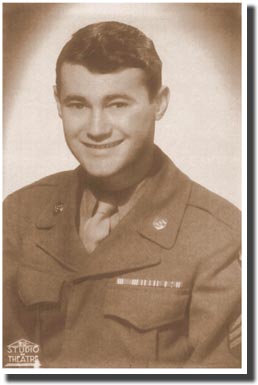 John S Wenzel
Enlistment Date: 18 Feb 1943, Private First Class, Graduate of Medical Technicians School at Fitzsimmons General Hospital in Denver Colorado 1943. Baxter General Hospital in Spokane, Washington, 1944. 1944-45 wardmaster with the 201st General Hospital at Verdun, France, John was in charge of five medical technicians who assisted the doctors and nurses in caring for combat casualties.
November 2009
My interviews tend to follow a simple format giving equal weight to the early years, the midyears, and ending with the present. That changed when John started talking how at the age of 18 he was drafted into the army during World War 2 and served with the medical corps during the Battle of the Bulge.
It became the focus of this interview covering his experiences from basic training to his discharge as a sergeant three years later. It is also a story of another era of united patriotism, shared sacrifice and of a war that ended in a clear victory. John also highlights his early years and life after the army including his business career and his marriage to Astrid. And as one of the early residents of The Crescent he shares some interesting anecdotes.
Astrid and John Wenzel
Click on any picture for larger version.
By Frank Soler
Tell us about your growing up years?
I was born in the village of Mamaroneck, NY located on Long Island Sound some 20 miles northeast of mid-Manhattan. My father and his two brothers owned a restaurant called Wenzel Brothers. It was on the waterfront and featured blue plate specials. When I was about twelve, my parents, sister and I moved a few miles north to Harrison NY. It was my hometown for the next fifteen years. One prominent resident was Amelia Earhart the pioneer aviatrix.
Among my fondest memories was the 20 minute trip with my father to see the New York Yankees play. I got to see Babe Ruth, Lou Gehrig and Joe DiMaggio when he joined the team in 1936. My favorite player was Phil Rizzuto who took over shortstop in 1941. Like me he was fast on his feet and small in stature.
In my teens, I took odd jobs to earn extra spending money. I caddied at the local golf courses and got $1 for 18 holes. When I got a tip it averaged between 25 and 50 cents. It was my first introduction to golf.
Jump ahead to high school.
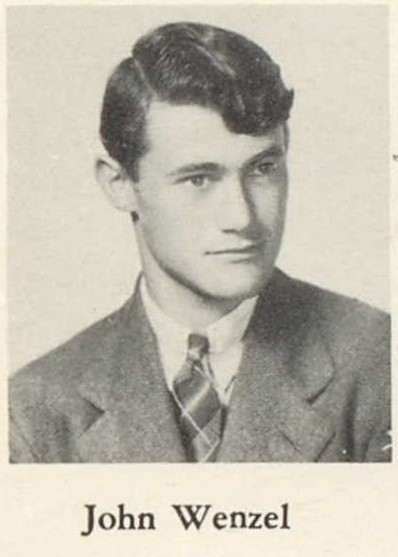 I attended Harrison High and went out for all sports. I weighed about 140 pounds, was fast, and made the track team running the 100 yard dash. Surprisingly, I also made the football team. I was so thin the coach didn't post my weight concerned the opposing team would go after me. He had a special play with the team assuming a short punt formation. I would line up behind the center, take the snap and hand it off to one of the full backs. The coach's instruction to the center was ''protect Wenzel.'' I graduated in June 1942. I attended Harrison High and went out for all sports. I weighed about 140 pounds, was fast, and made the track team running the 100 yard dash. Surprisingly, I also made the football team. I was so thin the coach didn't post my weight concerned the opposing team would go after me. He had a special play with the team assuming a short punt formation. I would line up behind the center, take the snap and hand it off to one of the full backs. The coach's instruction to the center was ''protect Wenzel.'' I graduated in June 1942.
What happen next after high school?
I was drafted into the army in February 1943. I was eighteen years old and like my classmates ready to serve. A group of us got on a school bus to go to processing camp. The driver took a detour to our high school where the high school band played for us. They were joined by a large crowd of students and townspeople who were cheering and waving the American flag. They wished us on to victory and a safe return.
My starting pay was $20 a month with $5 deducted for a $10,000 term life insurance policy with my mother the beneficiary. As I saw it, the army provided all my basic needs. On the home front, families had to adjust to rationing on food, gas and even some clothing.
Where did you take your basic training?
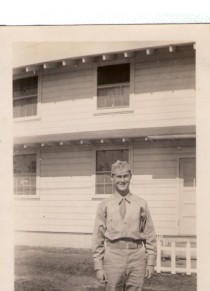 I was assigned to the medical corps. At the time, the army faced a critical shortage of medics as it planned the invasion of Europe. I expected a combat unit, but the army had a quota to fill.
I attended two medical training camps; Camp Robinson, Arkansas and Fitzimmons Army Medical Center, Colorado - each was eight weeks in duration. There were extensive classes on field splints, tourniquets, bandages, injecting antibiotics, penicillin, and giving blood plasma. I was assigned to the medical corps. At the time, the army faced a critical shortage of medics as it planned the invasion of Europe. I expected a combat unit, but the army had a quota to fill.
I attended two medical training camps; Camp Robinson, Arkansas and Fitzimmons Army Medical Center, Colorado - each was eight weeks in duration. There were extensive classes on field splints, tourniquets, bandages, injecting antibiotics, penicillin, and giving blood plasma.
We practiced taking blood samples on each other. I avoided those who had problems finding the vein.
We were required to pass an infiltration course to practice emergency treatment and evacuation of casualties under enemy fire. We were taught how to spot and avoid enemy anti-personnel landmines and booby traps. We were also trained on how to use the gas mask and to detect different gasses.
Sgt. John Wenzel, 1945
Any attempt to get into another branch?
Yes. There was an army air force camp near Fitzsimons and I applied for bombardier training. I passed the written and physical test but failed the eye examination. They said I was color blind. Looking back, the army would have probably rejected any transfer request.
Pictured Above: Sgt. John Wenzel, 1945
What came after Fitzsimmons?
I was deployed to the Baxter Army Hospital in Spokane, Washington. It was a fully staffed hospital with a 2,000 bed capacity tending the wounded and sick from the Pacific theater. It was my first experience serving the wounded.
I got a lucky break when ordered to accompany a discharged solider who still needed medical attention to his home in Maine. I was given a five day leave to visit my family. It was my only home leave during my three years of service.
Under the Geneva Convention, medics wearing the Red Cross armband are not allowed to carry weapons or to be fired upon. There were reports the Japanese were shooting at medics. Our unit was temporarily transferred to the infantry and taught how to shoot various weapons. On completion of this course we were transferred back to our unit. The fact that I earned a sharp shooters medal with the M-1 rife has always been a source of pride.
Did you serve overseas?
Since I was on the west coast, deployment to the Pacific made sense. The army had other plans. I was sent in the opposite direction and ended up serving in Verdun, France.
In July 1944, I reported to Camp Ellis, Illinois where the 201st General Hospital was being organized as a self-sustaining hospital. By mid October our unit consisted of some 150 personnel including surgeons, doctors, enlisted medics, medical technicians, cooks and ambulance drivers.
On October 31st we departed Boston on the SS West Point for Liverpool, England. The ship, formerly the SS America, usually accommodated 1,250 passengers. On our trip there were 8,000 troops on board with 5 tier beds everywhere. At the time, troopships traveled in a convoy for protection against submarine attacks. We were unescorted and told the ship's speed and sailing at night in total darkness was sufficient. Still, everyone kept their eyes out for submarines.
On December 25, we left Liverpool on the SS Sobieski for Le Havre, France with full escort. About 100 yards from land the ship dropped anchor and we climbed down the side of the ship onto landing crafts. We stayed a few days at the seaside town of Etretat, Normandy before taking a train to Verdun.
You mentioned the SS Leopoldville
One day before our trip, the troopship SS Leopoldville, with full escort, was taking our same course. It was torpedoed by a German U-Boat and sunk five miles from Le Havre. The death toll was 763 soldiers - many were 18 to 20 year old infantry replacements. One of my high school buddies survived. It's a reminder of the vagaries of war.
Tell us about the Verdun operation?
We arrived on January 1st, 1945 and took over a building formerly used by the French Calvary. We worked around the clock, and within two days we were ready to receive patients. The building was divided into two wards each accommodating 100 beds. Separate tents were set up for surgery, the medical technicians including dental and x-rays and for the mess hall.
There was a fierce battle to the north of us with mounting casualties. At the time, the German army was mounting its last major offensive to split our forces in two and stop the drive towards Germany. It became known as the Battle of the Bulge and lasted from December 14, 1944 to January 25, 1945.
Almost 20,000 Americans died four times as many as D-Day. More than sixty thousand were wounded needing medical attention. Existing medical units in the area were straining at full capacity.
Almost immediately ambulances started arriving with the wounded and sick. It wasn't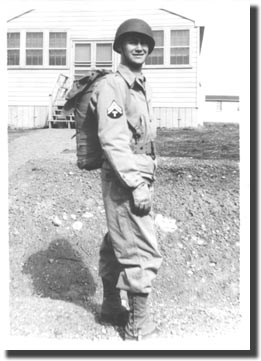 long before we were experiencing a strain on bed capacity. Our unit worked under constant pressure with the steady flow of incoming and outgoing patients. long before we were experiencing a strain on bed capacity. Our unit worked under constant pressure with the steady flow of incoming and outgoing patients.
The hospital's primary mission was treating the wounded as quickly as possible. Our head doctor had the responsibility to identify those suitable to return to their units or needed to be sent to evacuation hospitals for long-term care This decision accomplished two objectives to conserve the army's fightingstrength and to free up bed space for new casualties. The average stay at our unit was five to seven days. Most patients were returned to the combat zone.
At the time, I was a sergeant heading a team of medics tending one of the wards. My duties included setting the work schedule, providing my expertise and seeing that the head doctor's orders were followed. I was also in charge of a several local residents responsible for cleaning and other janitorial functions.
We treated thousands of soldiers' all like a family members. Among them was one of my high school classmates. He had a minor wound and was released back to his unit.
By February, the allied forces had advanced into Germany. With victory at hand, the army decided to keep using the General Hospitals in France. We also received wounded prisoners-of- war who were treated by a separate unit. So we were busy right up to the end of the fighting.
Sgt. John Wenzel
How did the war end for you?
Germany signed the terms of unconditional surrender on May 2nd. 1945. Several months later, our unit was sent to Marseilles for redeployment to the Pacific. By the time we got there, Japan surrendered and our unit was disbanded. I ended up working in a hospital in Nancy, France waiting for my discharge. When my time came, I shipped back to the states. I was discharged on March 16 1946 in Fort Dix, New Jersey.
Looking back, any closing comments?
I am proud to have worn the Army uniform and still feel a sense of satisfaction of serving my country during a time of war. General Eisenhower said, ''It takes teamwork to win battles and battles win wars.'' I think the 201st General Hospital was a part of that team.
How did you adjust to civilian life?
It was great being home again with my family. It was the little things that I had missed - seeing my old friends, sleeping in a real bed, wearing civilian clothes, and enjoying my mother's home cooking.
From day one my focus was earning a living following three years of military pay. I ruled out a career in medicine. There was talk of a coming housing boom stimulated by affordable mortgage for returning members of the military. Using the GI bill, I enrolled at the State College of Forestry at Syracuse University. In 1950 I earned my BS in wood product engineering. My degree included several courses related to business management.
I decided to seek employment close to my home town. As a starter, I became a salesman with the Mamaroneck Lumberyard - one of the largest retail/wholesale lumber companies in the area. I came to enjoy sharing my knowledge and working with customers.
When did Astrid enter into the picture?
Since high school, I had an eye on a cute red head with pig-tails. Her name was Astrid Gronlund, She was of Finnish descent. We were married in April 1952 in the All Saints' Church in Harrison. For our honeymoon we drove to Williamsburg, Virginia in my old 1940 Dodge that had seen better days. The fact that the windshield wiper wasn't working was the least of our concern. The Dodge made to Williamsburg and back without any mishaps.
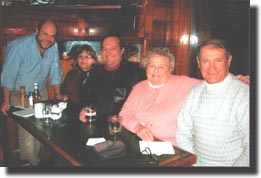 Left to right; ' Scott, Danuta (Arthur's wife), Arthur, Astrid and John Left to right; ' Scott, Danuta (Arthur's wife), Arthur, Astrid and John
Our first son Arthur was born in 1954 and Scott followed a few years later (1960). We are blessed with four grand children Paul, Stefan, John and Catie. We keep in close contact and exchange visits as often as possible.
Any career changes?
In 1954, the lumberyard's credit manager founded North Eastern Wholesalers' ' a building supply company catering to the trade. It sold a full line of products ranging from hand tools, power tools, locks, lighting, door hinges on down to nuts and bolts. These products were sold through an independent regional sales force located from Maine to Virginia. I was among the first to join this new venture.
In 1974, the owner retired and a group of us purchased the business. I became the President and oversaw the efforts of twenty employees engaged in sales, shipping, accounting, billing and office clerks. The people skills learned in the army were an asset. My duties included business planning and visiting suppliers and customers. After 20 years as President and 40 years with the company it was time to retire. I did so in 1991.
Did you ever go back to Verdun?
In 1994, Astrid and I went to France for the 50th Anniversary of D-Day. We took a side trip to Verdun, to visit some of men who worked for me during the war. We shared many stories and were treated as family. During this period, we took many vacation trips aboard including one to Finland to visit Astrid relatives.
What brought you to this area?
In 1976, we bought a condo in Palmetto Dunes for our winter vacations. By 1997 we were living full time in Hilton Head in a town house. After a few years, Astrid wanted to move to our own home were we could again have a pug as a pet. We found our ideal home in The Crescent and we moved in the spring of 2000. The same year our pug, Beauregard, joined the family.
What was The Crescent like in 2000?
I understand the first residents moved in the fall of 1999. We moved in December 18, 2000. There were many socials functions in the pool area. With few households, everyone knew everyone. There were no traffic lights at the front entrance. It often caused long delays crossing 278 or making a left turn towards Hilton Head. The residents complained until they were installed.
There were no guards at the front gate and the back gate didn't exist. In fact, the road leading to the Belfair shopping center was unpaved. Our son Arthur got stuck in one of the dirt potholes filled with sand. We had to get him out. When playing golf there were no houses between the 5th and 6th hole. Among my fondest memories was following Arnold Palmer when he gave two playing exhibition at The Crescent Golf Club.
What's ahead for you and Astrid?
Just to enjoy life in the low country, travel, and socialize with old and new friends. Astrid enjoys playing bridge at The Crescent and with friends on the island. She has been active with the Herb Society of Hilton Head for ten years and was recently elected President. As for me it is playing golf with a great bunch of guys three times a week. As for my current life's goal it is to get my first hole-in-one.
Closing Comments: John thanks so much for your time and participation in this interview. Your service during World War 2 is commendable and appreciated. It should remind us to support our brave troops now in harm's way and the wounded needing medical care.
Frank Soler
|
|
 |